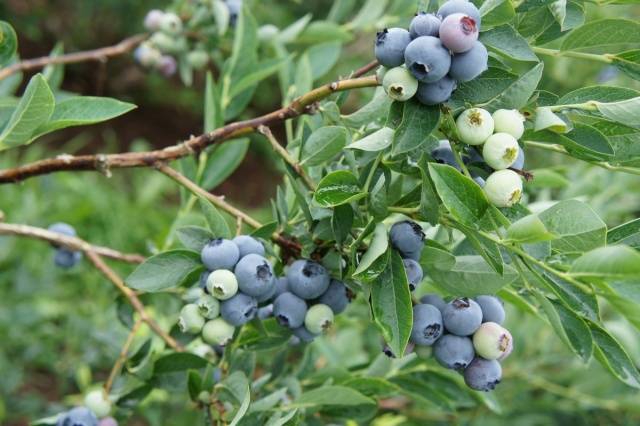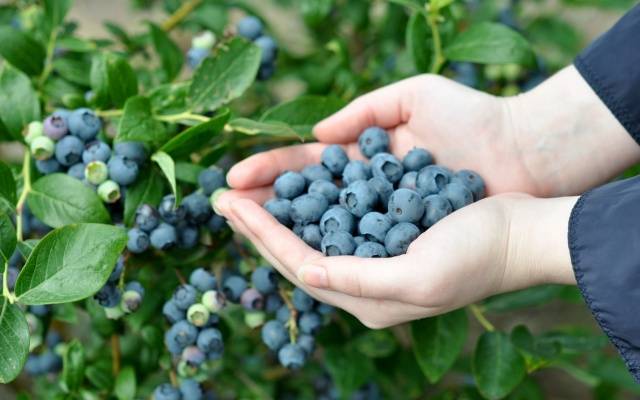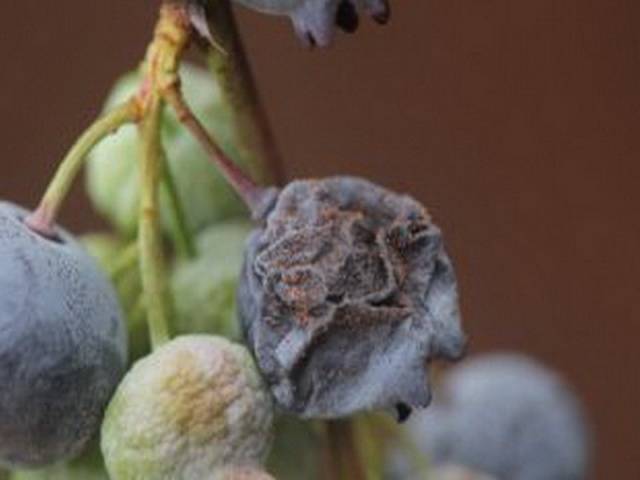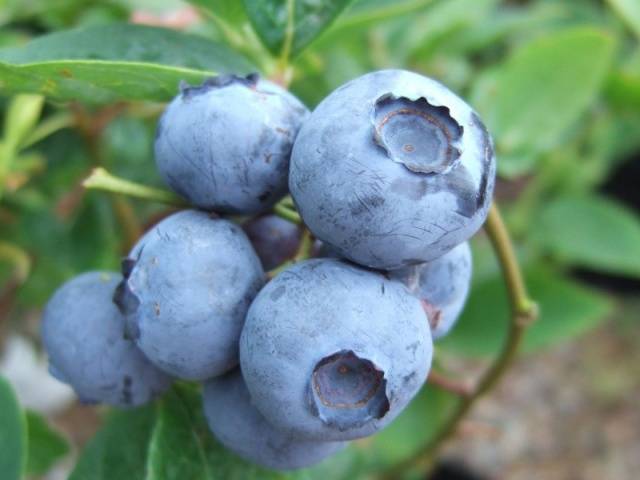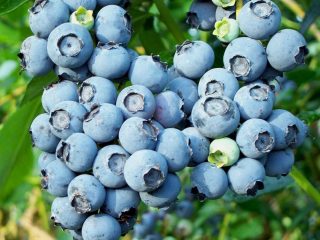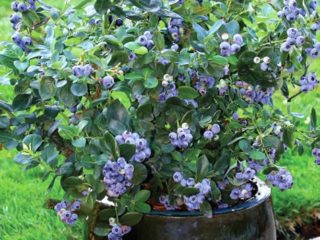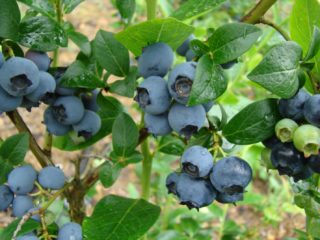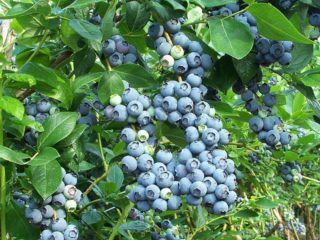Content
Blueberry Bluegold is a promising variety adapted to the Russian climate. When growing crops pay attention to the quality of the soil and care.
Breeding history
The tall blueberry Bluegold was bred in 1989 in the USA. The famous breeder Arlen Draper became the author of the variety. When working on the variety, we used tall forms of blueberries growing in swampy areas of North America.
Description of berry culture
Bluegold blueberries have a number of characteristics that make them stand out from other varieties.
General understanding of the variety
Blueberries are a perennial deciduous shrub. The root system is fibrous and branched, located at a depth of 40 cm.
Description of tall blueberry Bluegold:
- bush height up to 1.2 m;
- a large number of erect shoots;
- strong branches with a diameter of 2.5-3 cm;
- leaves are simple, elliptical.
At the end of August, the leaves of the shrub begin to change color. By the end of September, the bush is covered with burgundy leaves.
Berries
The taste appears simultaneously with the ripening of the berries. And they are colored much earlier than ripening. Fruits are easily separated from the stalk, often crumble at the stage of ripeness.
The fruit of the Bluegold variety is light blue and round in shape. Berries of medium size, 15-18 mm in diameter, weighing up to 2.1 g. The juice has no pronounced color. The pulp contains many seeds.
The fruit of the Bluegold variety is sweet and sour in taste. The sugar content is 9.6%. Tasting score - 4.3 points.
Photo of blueberry Bluegold:
Characteristic
By its characteristics, the Bluegold variety stands out among other varieties of this culture. The winter hardiness and yield of the variety deserve special attention.
Main advantages
Bluegold garden blueberries are moderately drought tolerant. Watering the bushes is one of the conditions for the fruiting of the culture.
The Bluegold variety is highly resistant to winter frosts. According to American experts, the bushes can withstand temperatures as low as -29 ... -35 ° C.
When growing crops in cold climates, there is a slight freezing of the shoots. In the spring, the bush quickly recovers. Freezing does not have a serious effect on the growth and productivity of the bushes.
Berries tolerate transportation well due to their dense skin. It is better to store and transport blueberries at low temperatures.
When the rules for planting and caring for Bluegold blueberries are followed, the bushes bring a stable harvest. The variety is considered one of the most unpretentious and is recommended for growing to novice gardeners.
The Bluegold variety is suitable for growing in the middle lane, in the North Caucasus, the Urals, Siberia and the Far East.
Flowering period and ripening time
Blueberry Bluegold begins to bloom in early June and ends at the end of the month. The variety bears fruit in the middle or late period, depending on the region of cultivation. The berries ripen in early August.
Yield indicators, fruiting dates
The variety brings its first harvest 4 years after planting. Regular fruiting begins at the age of 6. From one bush of Bluegold blueberries, 4.5 to 7 kg of berries are harvested.
The yield of the Bluegold variety is stable. Fruiting period: from the beginning to the end of August.
Scope of berries
Blueberries are used fresh, including for decorating pastries, making desserts and vitamin tea.
The collected berries are frozen or dried for long-term storage. They are used to prepare jams, juices, compotes, jams, and baking fillings.
Disease and pest resistance
The Bluegold variety has an average resistance to diseases and pests. The variety is prone to berry mummification and needs additional preventive treatments.
Advantages and disadvantages of the variety
Benefits of growing Bluegold blueberries:
- dense pulp;
- long-term storage;
- high productivity;
- self-fertility;
- resistance to winter frost.
Disadvantages of the Bluegold variety:
- high growth rate;
- fruits fall off after ripening;
- baking berries in the heat.
Landing rules
If you follow the planting rules, blueberries develop quickly and yield a high yield.
Recommended timing
It is recommended to plant the crop in spring. During the growing season, the bushes will have time to adapt to a new place. Autumn planting is allowed in warm regions.
Choosing the right place
Blueberries of the Bluegold variety grow well in illuminated areas, sheltered from the wind. The culture does not tolerate stagnation of moisture, so the bushes are planted on an elevated or level place.
Soil preparation
The culture prefers acidic soil with a pH of 4.0 - 5.0. For planting, a soil mixture is prepared, consisting of high-moor peat, sawdust, sand and fallen needles. In heavy clay soil, a drainage layer must be equipped.
Selection and preparation of seedlings
Bluegold seedlings are purchased in nurseries. The root system should be free from damage, mold and other defects. Before planting, blueberry roots are immersed in water for 2 hours. A seedling with a closed root system is watered.
Algorithm and scheme of landing
Planting order of the Bluegold variety:
Dig a hole 60 cm in diameter and 50 cm deep.Leave 1 m between the bushes.
Pour crushed stone and prepared soil mixture at the bottom.
Plant blueberries in the ground.
Water the seedling abundantly and cover the ground with bark, pine sawdust or peat.
Follow-up care of the culture
With constant care of Bluegold blueberries, its bushes are actively developing and bring a high yield.
Necessary activities
Excess and stagnation of moisture is destructive for culture. Bushes require moderate watering.
In early spring, Bluegold blueberries are fed with ammonium sulfate (100 g per bush), potassium (40 g) and magnesium (15 g). Every 7-10 days, the culture is watered with a solution of colloidal sulfur (1 g per 1 liter of water).
In order for the roots to better assimilate nutrients, the soil is loosened. Mulching the soil with sawdust or peat helps to reduce the number of watering.
Shrub pruning
Bushes over 6 years old need regular pruning. The procedure allows you to eliminate thickening and increase yields.
Be sure to eliminate root shoots and branches older than 6 years. 3-5 shoots are left on the bush.
Preparing for winter
The Bluegold variety tolerates winter well without shelter. The bush is fed with superphosphate (100 g). Young blueberries are covered with agrofibre, and in winter they are covered with a snowdrift.
Collection, processing, storage of crops
Bluegold blueberries are harvested by hand or using specialized equipment. After picking, the berries are stored in the refrigerator.
The Bluegold variety is suitable for sale. The berries are consumed fresh or processed to make homemade preparations. Blueberries can withstand long-term transportation and are suitable for industrial cultivation.
Diseases and pests, methods of control and prevention
The main diseases of the culture are shown in the table:
Disease | Symptoms | Control methods | Prophylaxis |
Fruit mummification | The first stage is the drying of the shoots, the appearance of a gray mass on them. The second stage - ripe berries wither and become orange or brown. | Spraying with Bordeaux liquid or Topsin solution. | Be sure to remove the affected fruits, which are the source of infection. Removal of fallen leaves. Preventive spraying with fungicides. |
Spotting | Reddish spots on the leaf blade, leaf fall. | Treatment of bushes with Bordeaux liquid or a solution of the drug Rovral. | Compliance with the rules of care: watering, fertilizing. Fungicide treatment. Mulching the soil. |
Blueberry pests and control measures are indicated in the table:
Pest | Signs of defeat | Ways to fight | Prophylaxis |
Fruit moth | The caterpillars of the fruit moth feed on buds, shoots and berries. | Treating the bush with Lepidocide with an interval of 10 days. | Pruning and burning broken and frozen shoots. Loosening the soil under the bush. Spraying with insecticides in spring and autumn. |
Gallica | The insect lays transparent eggs on the back of the leaf. | Elimination of damaged branches. Spraying with Fufanon. |
Conclusion
Blueberries Bluegold is a proven variety that is suitable for planting in the garden. Due to the high quality of the fruit, blueberries are grown on an industrial scale.
Testimonials
